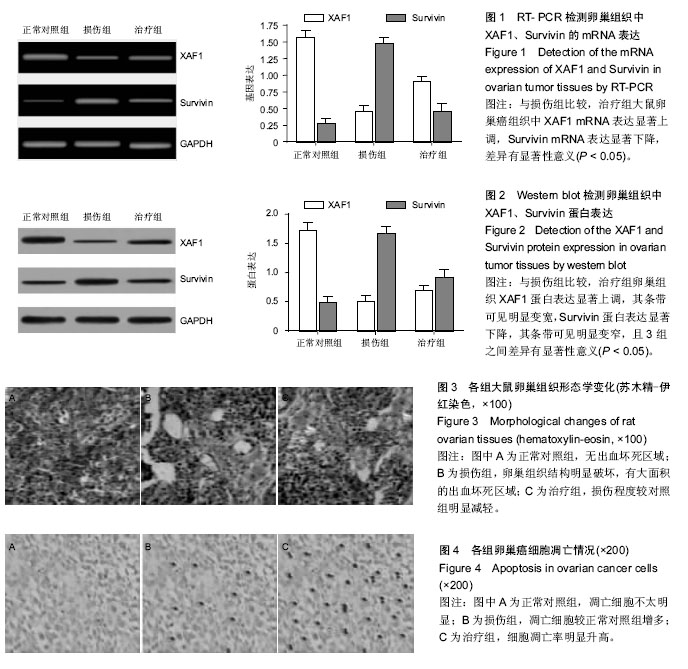| [1] Tchabo NE, Mhawech-Fauceglia P, Caballero OL, et al. Expression and serum immunoreactivity of developmentally restricted differentiation antigens in epithelial ovarian cancer.Cancer Immun. 2009;9:6.
[2] Moon N, Yang SJ, Park BB, et al. Efficient bone marrow transduction by gene transfer with allogeneic umbilical cord blood serum and plasma: an implication for clinical trials. Hum Gene Ther. 2008; 19(7):744-752.
[3] 胡卫华,王净,窦骏,等.IL-21修饰的脐血间充质干细胞对卵巢癌裸鼠治疗作用[J].现代免疫学,2010,30(3):222- 226.
[4] Brenner M1, Okur FV. Overview of gene therapy clinical progress including cancer treatment with gene-modified T cells. Hematology Am Soc Hematol Educ Program. 2009:675-681.
[5] Benjamin JE, Gill S, Negrin RS. Biology and clinical effects of natural killer cells in allogeneic transplantation. Curr Opin Oncol. 2010;22(2):130-137.
[6] Wagner JE. Umbilical cord transplantation: state of the art 2010. Semin Hematol. 2010;47(1):1-2.
[7] Sotiropoulou PA, Papamichail M. Immune properties of mesenchymal stem cells. Methods Mol Biol. 2007; 407: 225-243.
[8] Djouad F, Plence P, Bony C, et al. Immunosuppressive effect of mesenchymal stem cells favors tumor growth in allogeneic animals. Blood. 2003;102(10):3837-3844.
[9] 邵志红,王培军,李铭华,等.大鼠骨髓间充质干细胞移植对Walker-256肝癌生长影响的实验研究[J].中华医学杂志, 2009,89(7):491-496.
[10] Li GC, Ye QH, Xue YH, et al. Human mesenchymal stem cells inhibit metastasis of a hepatocellular carcinoma model using the MHCC97-H cell line. Cancer Sci. 2010;101(12):2546-2553.
[11] Zhu W, Xu W, Jiang R, et al. Mesenchymal stem cells derived from bone marrow favor tumor cell growth in vivo. Exp Mol Pathol. 2006;80(3):267-274.
[12] Lu YR, Yuan Y, Wang XJ, et al. The growth inhibitory effect of mesenchymal stem cells on tumor cells in vitro and in vivo. Cancer Biol Ther. 2008;7(2):245- 251.
[13] 乔玲,赵铁军,山长亮,等.人间充质干细胞抑制肝癌细胞增殖的作用及其基因表达谱分析[J].中国生物化学与分子生物学报,2007,23(12):1037-1044.
[14] 陈双庆,王培军,李铭华,等.磁标记骨髓间充质干细胞对肝细胞癌的抑制作用[J].临床放射学杂志,2009,28(10): 1454-1458.
[15] Dou J, Wang Y, Wang J, et al. Antitumor efficacy induced by human ovarian cancer cells secreting IL-21 alone or combination with GM-CSF cytokines in nude mice model. Immunobiology. 2009;214(6): 483-492.
[16] 李薇薇,俞丽芬.XAF1与消化道肿瘤细胞凋亡和自噬的关系[J].国际消化病杂志,2012,32(6):366-368.
[17] Phelps MA, Lin TS, Johnson AJ, et al. Clinical response and pharmacokinetics from a phase 1 study of an active dosing schedule of flavopiridol in relapsed chronic lymphocytic leukemia. Blood. 2009;113(12): 2637-2645.
[18] Strioga M, Viswanathan S, Darinskas A, et al. Same or not the same? Comparison of adipose tissue-derived versus bone marrow-derived mesenchymal stem and stromal cells. Stem Cells Dev. 2012;21(14):2724-2752.
[19] 周佳美,向慧玲,朱争艳,等. 大鼠骨髓间充质干细胞条件培养基对大鼠肝癌细胞系CBRH-7919增殖能力的影响[J].天津医科大学学报,2011,17(4): 455-458.
[20] 邱丽楠,韩凤娟,范明明,等.两种诱发Fischer344大鼠卵巢癌动物模型建立方法的比较[J].世界中西医结合杂志, 2010,5(6):488-490.
[21] 胡志勇,李冰燕,冯晓青,等.二甲基苯蒽卵巢被膜下注射诱发小鼠卵巢肿瘤模型[J].环境与职业医学,2011,28(8): 496-498.
[22] 霍晓溪,王心,王晶,等.紫杉醇治疗卵巢癌裸鼠移植瘤过程中WT1的表达及意义[J].中国肿瘤临床,2011,38(11): 621-625.
[23] Ling ZQ, Lv P, Lu XX, et al. Circulating Methylated XAF1 DNA Indicates Poor Prognosis for Gastric Cancer. PLoS One. 2013;8(6):e67195.
[24] 王书杰,韦艾凌,张永琴,待.癌痛消方调控大鼠移植性肝癌细胞Survivin及Bcl-2的实验研究[J].中国中西医结合杂志,2012,32(12):1652-1657.
[25] 程龙强,章尧,陈昌杰,等.肝细胞癌中载脂蛋白M,肝受体同系物1和肝细胞核因子1α表达的相关性分析[J].癌变•畸变•突变,2010,22(2):130-133.
[26] 葛成国,靳凤烁,李黔生,等.过表达Bcl-2雪旺细胞抗凋亡能力的实验研究[J].中国康复医学杂志,2004,19(2): 95-97.
[27] 牛志宏,高德轩,丁森泰,等.Cyr61,CTGF,NOV,WISP-1基因在肾癌中的表达[J].山东大学学报:医学版, 2008, 46(7):701-703,714.
[28] 王莉.华勒变性及少突胶质前体细胞和雪旺细胞移植[D].上海:上海交通大学,2008.
[29] 李军.嗅鞘细胞蛛网膜下腔移植治疗脊髓损伤的实验研究[D]. 上海:上海交通大学,2011.
[30] 连梓敏,曹定睿,王泓源,等.丙泊酚对Wistar大鼠肝癌模型中Bax与Bcl-2表达的影响[J].中国医学创新, 2014,11(12): 27-30.
[31] 马晓燕,曹定睿,苏丹丹,等.舒芬太尼对肝癌大鼠肝细胞凋亡的影响[J].中国现代药物应用, 2014,8(8): 243-244.
[32] Chung SK, Lee MG, Ryu BK, et al. Frequent alteration of XAF1 in human colorectal cancers: implication for tumor cell resistance to apoptotic stresses. Gastroenterology. 2007;132(7):2459-2477.
[33] Zou B, Chim CS, Zeng H, et al. Correlation between the single-site CpG methylation and expression silencing of the XAF1 gene in human gastric and colon cancers. Gastroenterology. 2006;131(6):1835-1843.
[34] Tu SP, Sun YW, Cui JT, et al. Tumor suppressor XIAP-Associated factor 1 (XAF1) cooperates with tumor necrosis factor-related apoptosis-inducing ligand to suppress colon cancer growth and trigger tumor regression. Cancer. 2010;116(5):1252-1263.
[35] 马建勋,达明绪,司若惶,等.Survivin基因在不同肝癌细胞中的表达及与Bcl-2/bax的关系研究[J].中国临床医学, 2009,16(3): 374-376.
[36] Adams JM, Cory S. The Bcl-2 apoptotic switch in cancer development and therapy. Oncogene. 2007; 26(9):1324-1337.
[37] 张雁瑞,肖萍. bax、Bcl-2在大肝癌、小肝癌中的表达差异及其意义探讨[J].吉林医学,2011,32(29) : 6083-6084.
[38] 彭利,左连富,齐凤英,等.凋亡抑制基因Survivin 在肝癌细胞中的表达及其与PTEN、cyclin D1 蛋白表达的关系[J].中国肿瘤临床,2005,32(1):29-33.
[39] Hylander B, Repasky E, Shrikant P, et al. Expression of Wilms tumor gene (WT1) in epithelial ovarian cancer. Gynecol Oncol. 2006;101(1):12-17.
[40] Skak K, Kragh M, Hausman D, et al. Interleukin 21: combination strategies for cancer therapy. Nat Rev Drug Discov. 2008;7(3):231-240.
[41] Bianco P, Robey PG, Simmons PJ. Mesenchymal stem cells: revisiting history, concepts, and assays. Cell Stem Cell. 2008;2(4):313-319.
[42] Lee DH, Ahn Y, Kim SU, et al. Targeting rat brainstem glioma using human neural stem cells and human mesenchymal stem cells. Clin Cancer Res. 2009; 15(15):4925-4934. |
.jpg)

.jpg)